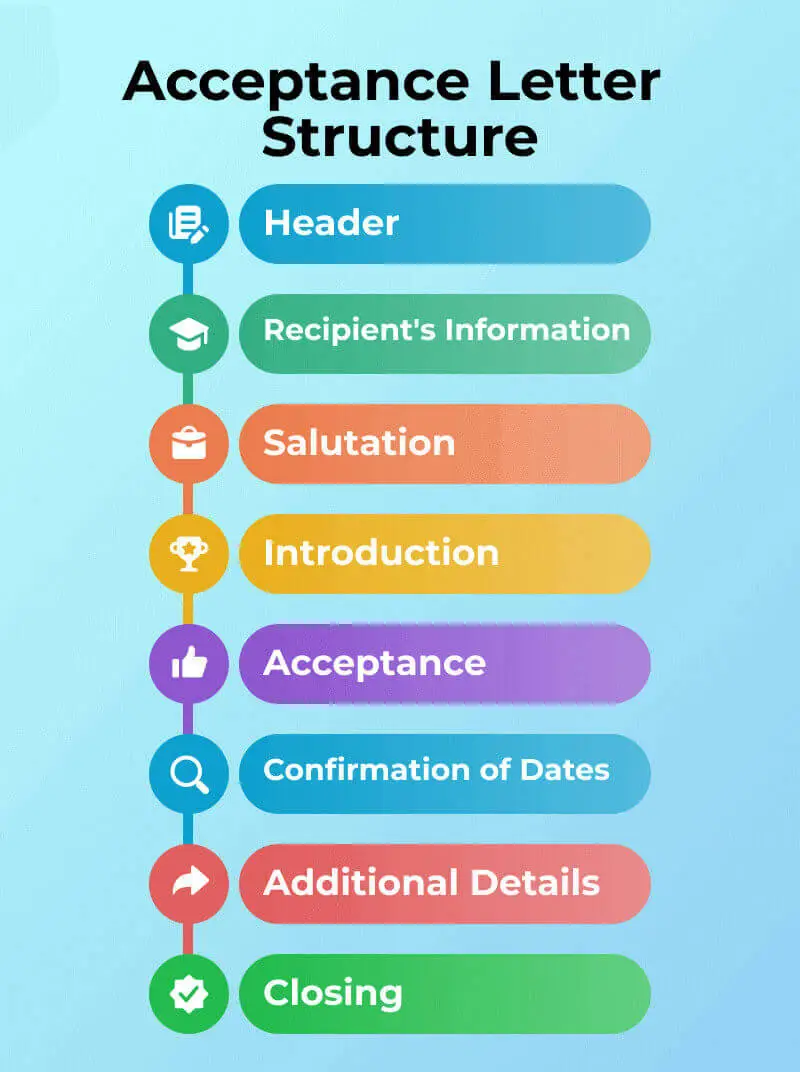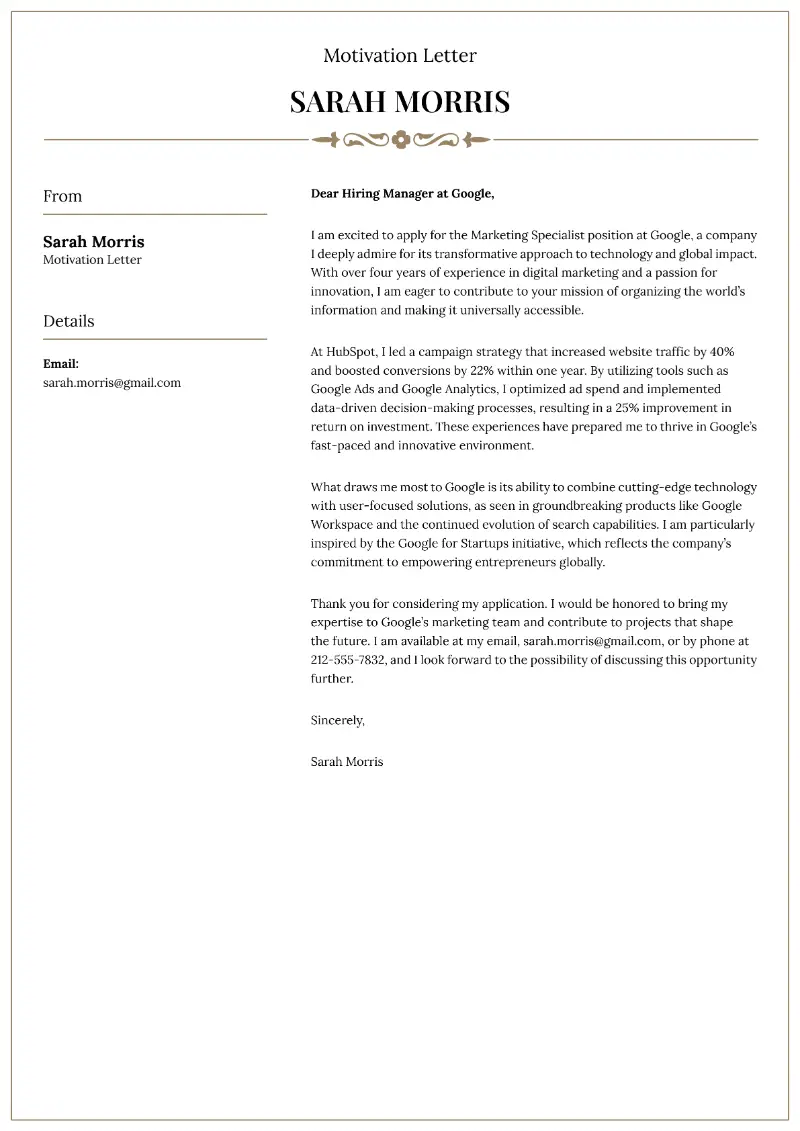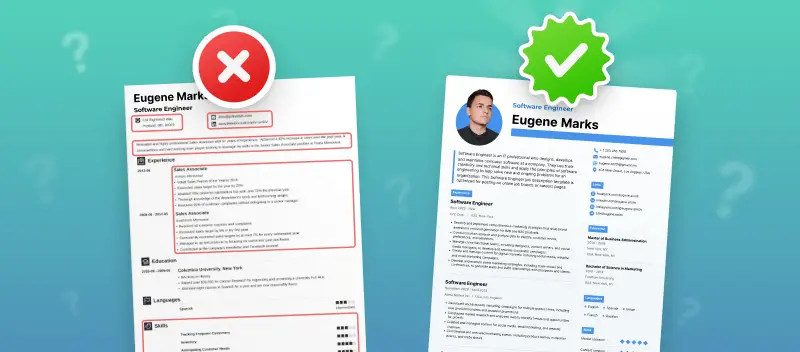Congratulations! After a stressful time of submitting applications and going through job interviews, you finally receive a job offer. Now it's time to make a decision of whether this is your dream role.
Accepting a job offer can be an exciting yet nerve-wracking experience. It's vital to handle this process with grace and professionalism.
In this article, you'll learn practical tips on how to accept a job offer with confidence. From evaluating the proposal to effectively communicating your expectations, we'll provide insights to ensure a smooth transition into your new role.
What Is a Job Offer?
Overall, a job offer is a formal document that outlines the terms and conditions of employment. It serves as the basis for the employment relationship between the employer and the candidate.
Attention:
Verbal expressions of interest from HR during an interview are positive indicators of their intentions. However, it's crucial to await a formal written confirmation. Until then, the job offer is not official.
A job offer typically consists of several key components:
- Job Title and Description. This section outlines the position being offered and provides a brief overview of the role's responsibilities, reporting structure, and any other pertinent details about the job.
- Salary and Compensation. The job offer must state details about the salary or hourly wage being offered. It also can mention additional compensation such as bonuses, commissions, or stock options.
- Start Date and Work Schedule. The offer specifies the expected start date for the new employee, along with details about the typical work schedule and any flexibility or remote work options.
- Conditions of Employment. This section may incorporate any conditions that must be met before employment can begin, such as passing a background check, drug screening, or providing proof of eligibility to work in the country.
- Employment Status. The job offer may specify whether the position is full-time, part-time, temporary, or an internship, as well as whether it is an exempt or non-exempt position under labor laws.
- Benefits and Perks. In addition to salary, the job offer may outline any benefits the employer provides. Examples are health insurance, retirement plans, paid time off, flexible spending accounts, or tuition reimbursement.
- Company Policies and Procedures. The offer may reference the company's laws and procedures, such as code of conduct, confidentiality agreements, intellectual property policies, and other terms of employment.
- Acceptance Deadline. HRs typically include a deadline by which the candidate must accept or decline the offer. This ensures that the employer can make alternate arrangements if the chosen person declines.
- Contact Information. The job offer usually contains contact information for the hiring manager or HR representative. This individual can answer any questions the applicant may have and facilitate the acceptance process.
- Relocation Assistance. If the role requires moving to a new location, the document might specify any support or reimbursement provided by the employer.
Job offers often contain formal language and legal jargon to ensure clarity and protect both parties' interests. It's essential for candidates to carefully review the offer and seek clarification on any terms they don't understand before accepting.
How to Accept a Job Offer?
The process of accepting a job proposal is filled with excitement and nervousness. It's a big decision that can have a significant impact on your career and life. That's why it's crucial to understand the proper way to manage this situation and come to the optimal decision for yourself.
Upon receiving a job offer letter, follow these steps:
- Evaluate the job offer.
- Seek clarification.
- Negotiate if necessary.
- Follow up in writing.
- Prepare for onboarding.
- Ensure all terms match what was discussed verbally.
Now, let's take a closer look at each step of the process to ensure a comprehensive understanding of accepting a job offer.
Step 1. Receive an Offer
Before rushing into a decision, take a moment to pause and thoroughly assess the job offer. If you have received a verbal job proposal, request a written one for clarity and documentation purposes.
Receiving a written job offer is crucial as it provides formal confirmation of employment terms, such as salary and start date, helping prevent misunderstandings.
When you receive a job offer, the first instinct may be to immediately accept or decline it. Nonetheless, it is necessary to inquire with the employer about their desired response timeframe.
When asking for a timeline, keep in mind that the employer may have other candidates they are considering. It is important to respect their time and give them a reasonable deadline for your response.
Step 2. Seek Clarification
If any aspect of the offer is unclear or requires further explanation, don't hesitate to reach out to the hiring manager for clarification.
When reading a job offer, pay attention to the following key aspects:
1. Job responsibilities
Review the description of your roles and duties to ensure they align with your skills, experience, and career goals. Look for clarity on the tasks you'll be expected to perform and any specific projects or objectives.
2. Salary and compensation
Take note of the offered salary, including any bonuses, incentives, or commission structures. Consider whether the package meets your financial needs and expectations.
3. Benefits package
Beyond just the salary, the benefits can significantly impact your overall compensation and quality of life.
| Benefit | Description |
|---|---|
| Healthcare Coverage | Provision of medical, dental, and vision insurance to cover healthcare expenses. |
| Retirement Plans | Programs such as 401(k) plans where employees can save a portion of their income for retirement. |
| Paid Time Off | Allocation of PTO for vacation, sick leave, and holidays providing time away from work. |
| Flexible Work Arrangements | Options for employees to work remotely, adjust their schedules, or work part-time. |
| Tuition Reimbursement. | Financial assistance for continuing education or pursuing further academic qualifications. |
| Wellness Programs | Initiatives promoting employee well-being, such as gym memberships, wellness workshops, or health screenings. |
| Life Insurance | Financial protection of the employee and their family in the event of death or disability. |
| Disability Insurance | Income protection in case of disability that prevents them from working. |
| Stock Options | Grants workers the option to buy company shares at a predetermined price. |
| Employee Assistance Programs | Counseling services and resources provided to staff to address personal or work-related issues. |
| Parental Leave | Time off granted to parents to care for a new child, including maternity and paternity leave. |
| Commuter | Subsidies or pre-tax benefits to help cover transportation costs such as public transit or parking. |
4. Work schedule and location
Consider the expected work schedule, including regular hours, flexibility, remote options, and the location of the job. Determine whether location are compatible with your lifestyle and commuting preferences.
5. Employment status
Clarify whether the job offer is for full/part-time, temporary, or contract employment.
| Status | Description |
|---|---|
| Full-Time | Employees typically work a standard number of hours per week, often 35 to 40 hours, and are eligible for benefits such as health insurance and retirement plans. |
| Part-Time | Work fewer hours than full-time employees, often on a flexible schedule, and may receive prorated perks such as vacation time. |
| Temporary | People are hired for a specific period or project and may be employed directly or through a staffing agency. They may receive limited benefits. |
| Contract | Individuals work for a fixed term under a contract outlining terms like duration, scope of work, and compensation. Benefits vary based on contract terms. |
| Freelance/Independent Contractor | Self-employed individuals who provide services on a project basis. They manage their own schedules, clients, and business expenses. |
| Internship | Interns gain practical experience in a field or industry through temporary work, often as students or recent graduates. Internships may be paid or not. |
| Seasonal | Employees hired to work during peak periods, such as holidays or summer months, often with limited benefits. |
Review the terms and conditions of employment, including probationary periods, termination clauses, and any non-compete agreements. Pay attention to any legal or contractual obligations.
| Aspect | Description |
|---|---|
| Probationary Periods | A trial period at the beginning of employment, typically around 90 days, during which the employer and employee assess each other's suitability for the role. Either party can terminate the relationship without cause or notice during this time. |
| Termination Clauses | Specify conditions under which either party can end the employment relationship, including notice timelines, reasons for letting go (with or without cause), and any severance or benefits. |
| Non-Compete Agreements | Contracts in which an employee agrees not to engage in competitive activities, such as working for a competitor or starting a business, for a specified period. Must be reasonable in scope, duration, and geographic area to be enforceable. |
Step 3. Contract Negotiation
Negotiating your job offer is an important step in the job acceptance process. It allows you to advocate for yourself and ensure that the terms of employment align with your expectations and worth.
Here are some key points to consider:
- Know Your Worth. Research typical salary ranges for your position and level of experience in your industry and location. Use resources such as salary surveys, job market reports, and online tools to understand your value.
- Initiate the Conversation. Express your interest in the job and gratitude for the offer before broaching the topic of negotiation. Request a meeting or phone call with the employer to discuss the offer in more detail.
- Present Your Case. Clearly articulate your reasons for negotiating, citing relevant factors such as your qualifications, experience, market research, and the value you bring to the organization. Provide specific examples of your achievements and contributions that justify your request.
- Be Flexible. Be open to compromise and alternative solutions that meet both your needs and the employer's priorities. Consider creative options such as performance-based bonuses, additional vacation time, or professional development opportunities.
- Get It in Writing. Ensure that all negotiated terms are documented in written form, either as part of the official offer letter or in a separate agreement. Review the document carefully to confirm that it accurately reflects the terms you've agreed upon before signing.
Step 4. Affirm Your Acceptance
Now that you have received a job offer letter, it's time to confirm your acceptance. This step is crucial in securing the job and starting your new career journey.
Begin by showing appreciation for the opportunity. Let the employer know that you are excited about the opportunity and appreciate their confidence in you.
Next, clearly state that you are accepting the job offer. Use simple and direct language to avoid any confusion.
Remember to send a written job acceptance email to make it official.
If an employment opportunity has been extended to you and you have agreed to it, it is essential to update other prospective employers who may still be evaluating you for a job. This not only shows professionalism but also allows them to move forward with other candidates. A simple email or phone call will suffice.
Step 5. Prepare for the New Job
Take the time to complete any required paperwork or pre-employment requirements. Stay in communication with the employer or HR department to ensure a smooth onboarding process.
Here are some common documents and forms you may need to fill out:
| Form | Description |
|---|---|
| Employment Agreement | Document outlining conditions of work, including job title, salary, start date, etc. |
| Tax Forms | W-4 for federal income tax and state tax withholding forms. |
| Direct Deposit Authorization | Blank to provide bank account information for setting up direct deposit. |
| Benefits Enrollment | Forms to enroll in employer-offered perks like health insurance, retirement plans, etc. |
| Non-Disclosure Agreement | Paper outlining responsibilities regarding confidentiality of company information. |
| Emergency Contact Information | Form to input the data of your emergency contacts. |
| Form I-9 | Document verifying identity and eligibility to work in the United States. |
| Employee Information Form | Paper collecting basic personal and contact details. |
| Acknowledgment of Company Policies | Forms acknowledging understanding of the regulations (anti-discrimination, harassment, etc.). |
| Certification Agreements | Contracts regarding commitment to complete specific training or certifications. |
| Background Check Authorization | Consent form allowing the company to perform criminal and credit history checks if applicable. |
Before signing your document, make sure you have carefully read and understood all the details of the contract. Double-check important information such as your job title, salary, benefits, and start date. If there are any discrepancies, bring them up with your employer prior to signing.
Once the terms of the contract meet your approval, it's time to put pen to paper and seal the deal by formalizing it. This signifies your acceptance of the job offer and shows your commitment to starting a new chapter in your career.
Keep in mind to save a copy of the signed contract for your records.
Acceptance Letter
A letter of acceptance is a formal communication sent by a candidate to an employer to officially confirm a job offer. It serves as a written confirmation of the job seeker's acceptance of the conditions.

The letter typically expresses gratitude for the opportunity and confirms the applicant's commitment to joining the organization.
How to respond to the job offer?
Key components:
- Gratitude. Express appreciation for the opportunity to join the company.
- Confirmation. Make it clear that you accept the job offer.
- Terms Acceptance. Acknowledge the agreement to the terms set forth in the job proposal, including salary, benefits, start date, and any other relevant details.
- Contact Information. Provide your contact information: full name, address, phone number, and email.
- Formal Closing. Close the letter with a professional closing, such as "Sincerely" or "Best Regards", followed by your signature.
Job Offer Acceptance Letter Examples
For Candidates Who Negotiated Their Offer
Dear Mr. Martens,
I am delighted to accept the job offer for the Content Manager position at Schulist Inc. I am thrilled about the opportunity to contribute my skills and expertise to your team and to be part of such a dynamic and innovative company.
I want to extend my sincere gratitude for your willingness to engage in the negotiation process and for considering my requests. I am confident that the terms we've agreed upon will allow me to thrive in this role.
As per our discussions, my start date will be May 16, 2024. I am prepared to complete any necessary onboarding procedures prior to that time. Please let me know if there are any additional steps I need to take before joining the team.
Thank you once again for this wonderful opportunity. I am looking forward to joining Schulist Inc. and contributing to its continued growth and success.
Warm regards,
Tamika W. Gates
For Candidates Who Didn’t Negotiate Their Offer
Dear Mrs. Sun,
I am writing to formally accept the offer of employment for the position of Software Engineer at Cole LLC. I am honored to have been selected for this opportunity and am excited to become a part of the company's success.
I am convinced that my skills and experience make me a good fit. I am eager to hit the ground running and make a meaningful contribution to the company's projects and initiatives.
I confirm my commitment to start on April 5, 2024, as agreed. I will be able to go through any required training prior to my first day to ensure a seamless entry into the role.
Thank you for this incredible opportunity.
Sincerely,
Edwin M. Hernandez
Conditional Job Offer Acceptance Letter
Dear Ms. Harrison,
I am pleased to accept the conditional offer for the Marketing Manager position at GreenTech Solutions, Inc., as outlined in your letter dated December 10, 2024. I understand that my acceptance is contingent upon the successful completion of the background check and final approval from your executive team.
I look forward to joining the team and starting on February 5, 2025, once all conditions are met. Please let me know if there’s anything further I need to provide.
Thank you for this opportunity.
Sincerely,
Eli Dawson
FAQ
- What to do if I receive a job proposal but I'm still waiting to hear back from other companies?
- It's essential to be transparent with the hiring manager about your situation. Politely ask for a reasonable extension to make your decision, expressing your enthusiasm for the opportunity but explaining your need to see all options.
- If I accepted a job offer but later received a better one from another company, what should I do?
- While it's not ideal to renege on a job offer after accepting it, sometimes circumstances change. Communicate with both employers respectfully and professionally. It's vital to prioritize honesty and integrity throughout the process and handle the situation with care.
- What should I do if I need to relocate for the job?
- If the job requires relocation, research the new place, including housing options, cost of living, and local amenities. Additionally, discuss relocation assistance or reimbursement options with the employer and make sure you have a clear understanding of what support will be provided.
- How do I handle multiple job offers received simultaneously?
- Evaluate each based on salary, benefits, company culture, growth potential, and location. Prioritize your personal values, and communicate transparently with all parties to make informed decisions within any deadlines.
Create your professional Resume in 10 minutes for FREE
Build My Resume
Conclusion
In conclusion, navigating the process of accepting a job offer requires careful consideration and thoughtful decision-making. By following the steps outlined in our guide, individuals can approach this important milestone with confidence and clarity.
Remember, your acceptance letter for a job is not just about securing employment. It's about finding the right fit for your skills, values, and career goals. So, take the time to assess your options, communicate effectively, and ultimately make a decision that aligns with your professional aspirations.



